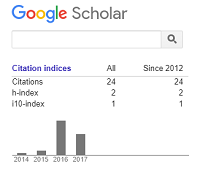Effectiveness of Constructivism Approach to Increase Mathematical Communication Skill of Students Junior High School
DOI:
https://doi.org/10.18592/jpm.v5i2.2000Keywords:
Constructivism, Approach, Mathematical, Communication, SkillAbstract
The purpose of this study was to analyze and explore the effectiveness of constructivism approaches in improving mathematical communication skills of junior high school students in the city of Paser. The experimental quasi method was used in this study to test the hypothesis of the study. The sample of the study at three junior high schools in Paser City, representing high, medium and low school students.. The instruments used in this study were pre-post test, pre-post questionnaires, and observation. The data were analyzed using independent sample t-tests, paired sample tests, annova tests, and descriptive analysis. The findings of pre-post test and pre-post questionnaire analysis using t-test showed that there were significant differences in group mathematical communication skills using constructivism approach compared to groups using conventional approaches at all achievement levels of high school students (high, simple and low). Based on the observation, it is found that high achievement school students have good mathematical communication skills in mathematical communication, these are identified in many aspects and observation indicators achieved by students during learning.References
Ahmad Fauzan. (2008). Problematika Pembelajaran Matematika dan Alternatif Penyelesaiannya. (Publish). Thesis Master. Padang: Padang University.
Chua, Y.P. (2006). Research Method. (Second Edition). Kuala Lumpur: McGraw Hill.
Creswell, J.W. (2008). Educational Research. Planning, Conducting, and Evaluating Qualitative & Quantitative Approaches. London: Sage Publications.
Creswell, J.W. (2012). Research Design Qualitative Research, Quantitative, and Mixed. Edisi ke-2. NJ: Pearson Education, Inc.
Depdiknas. (2006). Kurikulum Tingkat Satuan Pendidikan. Jakarta: Depdiknas.
Fraser, B.J. & Walberg, H.J. (1995) Improving Sciense Education. Chicago : The National Society for The Study of Education.
Gagnon, G.W. & Collay, M. (2001). Designing for Learning: Six Elements in Contructivist Classroom. California: Corwin Press Inc.
Gurria, A. (2013). PISA 2012 Results in Focus. Download by: http://www.oecd.org/pisa/keyfindings/pisa-2012-results-overview.pdf.
Hanafiah Nanang & Cucu Suhana. (2009). Konsep Strategi Pembelajaran. Bandung: PT Refika Aditama.
Lim, C.S. & Chew, C.M. (2007). Mathematical Communication in Malaysian Bilingual Classrooms. (Unpublished) Conference at Sultan Idris Education University. Tanjung Malim, Perak.
Marpaung. (2011). Inovasi Pembelajaran Matematika Berbasis Teknologi Untuk Mempersiapkan Siswa Menjadi Generasi Kompetitif/Comparatif. Seminar at Wijaya Kusuma University, Surabaya 18 July 2011.
Mohd. Uzi Dollah., Noor Shah Saad., Nizam Lee., (2014). Nilai-Nilai Dalam Pendidikan Matematik di Sekolah Menengah. (Unpublished). Perak: Sultan Idris Education University.
Mullis, I. P. S., Martin, M.O., & Foy, P. (2011). Results in Mathematics. Chestnot Hill, MA, USA: TIMSS & PIRLS International Study Center. Download by Http://timssandprils.bc.edu.tims2011.downloads/T11_IR_Mathematics_FullBook.pdf.
National Council of Teachers of Mathematics (NCTM). (2000). Principles and Standards for Scholl Matematics. Reston:NCTM,Inc.
Nur Izzati,. (2012). Peningkatan Komunikasi Matematis dan Kemandirian Belajar Siswa pada Sekolah Menengah menggunakan Pendekatan Matematika Realistik. (Publish) Thesis Master). Bandung: Education University Indonesia.
Smith, R.S. (2008). The role of auxin transport in plant patterning mechanisms. PLoS Biology 6,e323
Sugiyono. (2013). Metode Penelitian Pendidikan Pendekatan Kuantitatif, Kualitatif, dan R&D. Bandung: Alfabeta.





